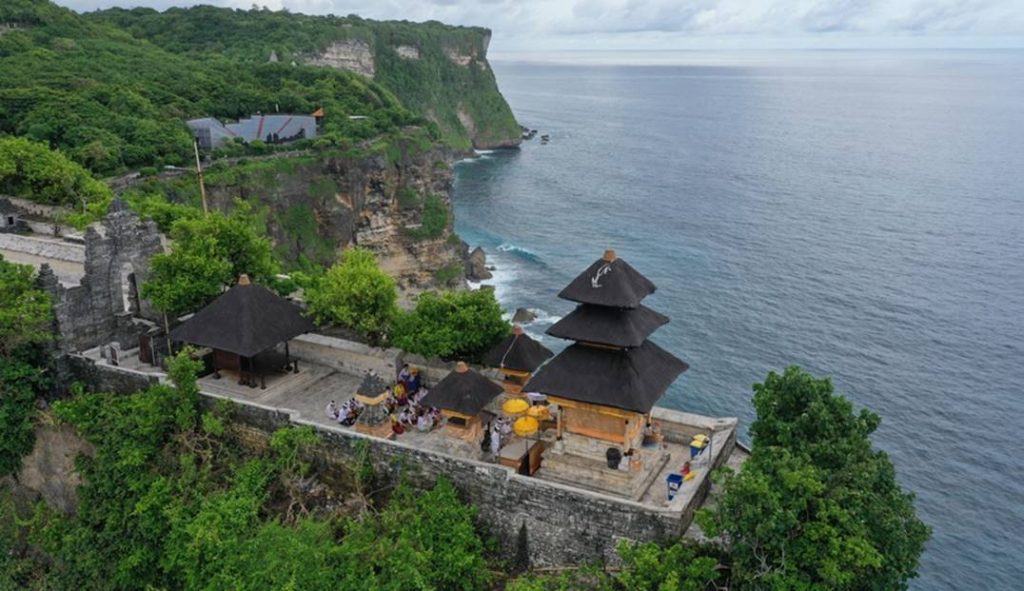Uluwatu Temple – Pura Luhur Uluwatu: Bali’s Cliffside Spiritual Sanctuary
Uluwatu Temple, known locally as Pura Luhur Uluwatu, is one of Bali’s most iconic and revered sea temples. Perched on the edge of a steep cliff overlooking the Indian Ocean, this ancient temple is a must-visit for anyone seeking to experience the spiritual and cultural essence of Bali. With its breathtaking views, rich history, and unique cultural performances, Uluwatu Temple offers visitors an unforgettable glimpse into the island’s heritage.
A Temple Steeped in History
Pura Luhur Uluwatu is one of the six key temples believed to be Bali’s spiritual pillars. The temple is dedicated to the spirits of the sea and is considered a sacred place where the powers of the gods converge. According to local legend, the temple was established by a Javanese Hindu priest named Empu Kuturan in the 11th century. Later, it was expanded by another revered priest, Dang Hyang Nirartha, who is believed to have attained moksha (spiritual liberation) at the site.
The temple’s name, “Luhur Uluwatu,” reflects its location and significance. “Luhur” means “something of divine origin,” and “Uluwatu” is derived from “Ulu,” meaning “land’s end,” and “Watu,” meaning “rock.” Together, they describe the temple’s position at the southwestern tip of Bali, on a rugged limestone cliff that towers 70 meters above the ocean.
Architectural Splendor and Sacred Grounds
The architecture of Uluwatu Temple is a stunning example of traditional Balinese design. The temple complex is built from black coral rock, giving it a unique and ancient appearance. The intricately carved gateways, statues, and shrines reflect the skill and artistry of Balinese craftsmen. The temple’s location on the cliff adds to its dramatic presence, with the ocean waves crashing against the rocks below, creating a mesmerizing backdrop.
Visitors can explore the temple grounds, which are spread across several tiers connected by stone pathways. The inner sanctum, where the main shrine is located, is usually closed to the public, as it is reserved for worshippers. However, the outer areas of the temple are open for exploration, and visitors can admire the stunning views of the ocean and the surrounding landscape.
The Kecak Dance: A Cultural Highlight
One of the most popular attractions at Uluwatu Temple is the nightly Kecak dance performance. Held in an open-air amphitheater on the temple grounds, the Kecak dance is a mesmerizing cultural experience that brings to life scenes from the Hindu epic, the Ramayana. The performance begins as the sun sets, casting a golden glow over the ocean and the temple.
The Kecak dance is unique in that it features no musical instruments. Instead, a chorus of about 70 men chant “cak” in rhythmic unison, creating a captivating soundscape. The dance tells the story of Prince Rama, who, with the help of the monkey god Hanuman, rescues his wife Sita from the demon king Ravana. The combination of the chanting, the dancers’ dramatic movements, and the fiery torches used in the performance make for an unforgettable experience.
The Sacred Monkeys of Uluwatu
As you explore the temple grounds, you’ll likely encounter the resident population of long-tailed macaques. These monkeys are considered sacred by the locals and are believed to be the temple’s guardians. While they are a fascinating sight, it’s important to be cautious around them, as they are known for their mischievous behavior. It’s advisable to keep a close eye on your belongings, as the monkeys have been known to snatch items from unsuspecting visitors.
Practical Information for Visitors
Uluwatu Temple is located about an hour’s drive from Bali’s main tourist areas, such as Kuta and Seminyak. The temple is open to visitors daily from 9:00 AM to 7:00 PM, with the Kecak dance performance typically starting around 6:00 PM. It’s recommended to arrive early to secure a good spot for the performance, as it can get crowded.
As with all temples in Bali, visitors are required to dress modestly. Sarongs and sashes are available at the entrance and should be worn by both men and women. The entrance fee includes the use of these garments, as well as access to the temple grounds.
The Spiritual Significance of Uluwatu Temple
Pura Luhur Uluwatu is more than just a stunning location; it’s a place of deep spiritual significance for the Balinese people. The temple is an important site for rituals and ceremonies that honor the gods and the spirits of the sea. For visitors, it offers a chance to experience the spiritual energy that permeates Bali, while also providing some of the most breathtaking views on the island.
Whether you’re drawn to the temple’s historical significance, its architectural beauty, or the captivating Kecak dance, Uluwatu Temple is a destination that should not be missed. It’s a place where the natural and spiritual worlds come together, creating an experience that is both awe-inspiring and deeply moving.
